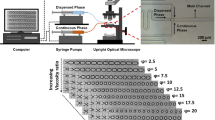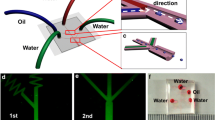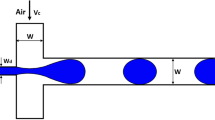Abstract
In droplet microfluidic devices with suction-based flow control, the microchannel geometry and suction pressure at the outlet govern the dynamic properties of the two phases that influence the droplet generation. Therefore, it is critical to understand the role of geometry along with suction pressure in the dynamics of droplet generation to develop a predictive model. We conducted a comprehensive characterization of droplet generation in a flow focusing device with varying control parameters. We used these results to formulate a scaling argument and propose a governing parameter, called as modified capillary number (CaL), that combines normalized droplet volume with geometrical parameters (length of dispersed and continuous phase channels) and flow parameters (interfacial tension, phase viscosity and velocity) in a power law relationship. CaL effectively captures the transition from squeezing to dripping regimes of droplet generation, providing essential insights into the design requirements for suction-driven droplet generation. These findings are key to standardize microfluidic flow-focusing devices that can achieve the desired droplet generation behavior with optimal pressure consumption.






Similar content being viewed by others
Data availability
Experimental data presented in his study is available upon request to the authors.
Abbreviations
- Ca:
-
Capillary number
- CaL :
-
Modified capillary number
- μ C :
-
Viscosity of continuous phase
- μ D :
-
Viscosity of dispersed phase
- G :
-
Characteristic rate of strain
- n :
-
Characteristic size of neck
- V :
-
Droplet volume
- v D :
-
Velocity of dispersed phase
- v C :
-
Velocity of continuous phase
- γ :
-
Interfacial tension
- λ :
-
Viscosity ratio
- φ :
-
Flow rate ratio
- Q D :
-
Dispersed phase flow rate
- Q C :
-
Continuous phase flow rate
- R D :
-
Hydraulic diameter of dispersed phase inlet
- R D :
-
Hydraulic diameter of continuous phase inlet
- d :
-
Droplet diameter
- d L :
-
Droplet length
- w :
-
Channel width
- ϵ :
-
Shear rate
- ω :
-
Droplet velocity/average cont. phase velocity
- C λ :
-
Correction factor
- α :
-
Ratio of effective cross-section area of channels
- t n :
-
Time between initiation and breakup
- ∆P D :
-
Pressure drop in dispersed phase channel
- ∆P C :
-
Pressure drop in continuous phase channel
- P atm :
-
Absolute atmospheric pressure
- P j :
-
Absolute pressure at the junction
- L D :
-
Length of dispersed phase channel
- L C :
-
Length of continuous phase channel
- L :
-
Length ratio
- δW S :
-
Work done per unit area
- δα :
-
Work done by stretching
- δH :
-
Work done by bending
- δD :
-
Work done by torsion
- ∆A :
-
Surface element
- B :
-
Bending moments
- \( \vartheta \) :
-
Torsion moment
- VDrop :
-
Observed droplet volume
- \(\overline{{\text{V}} }\) Drop :
-
Scaled droplet volume
References
Abate AR, Weitz DA (2011) Syringe-vacuum microfluidics: a portable technique to create monodisperse emulsions. Biomicrofluidics 5(1):014107. https://doi.org/10.1063/1.3567093
Baroud CN, Gallaire F, Dangla R (2010) Dynamics of microfluidic droplets. Lab Chip 10(16):2032–2045. https://doi.org/10.1039/C001191F
Bong KW, Chapin SC, Pregibon DC, Baah D, Floyd-Smith TM, Doyle PS (2011) Compressed-air flow control system. Lab Chip 11(4):743–747. https://doi.org/10.1039/C0LC00303D
Brouzes E, Medkova M, Savenelli N et al (2009) Droplet microfluidic technology for single-cell high-throughput screening. Proc Natl Acad Sci 106(34):14195–14200. https://doi.org/10.1073/pnas.0903542106
Chou WL, Lee PY, Yang CL, Huang WY, Lin YS (2015) Recent advances in applications of droplet microfluidics. Micromachines 6(9):1249–1271. https://doi.org/10.3390/mi6091249
Christopher GF, Anna SL (2007) Microfluidic methods for generating continuous droplet streams. J Phys d: Appl Phys 40(19):R319. https://doi.org/10.1088/0022-3727/40/19/R01
Cubaud T, Mason TG (2008) Capillary threads and viscous droplets in square microchannels. Phys Fluid 20(5). https://doi.org/10.1063/1.2911716
De Jonghe J, Kaminski TS, Morse DB et al (2023) spinDrop: a droplet microfluidic platform to maximise single-cell sequencing information content. Nat Commun 14(1):4788. https://doi.org/10.1038/s41467-023-40322-w
De Menech M, Garstecki P, Jousse F, Stone HA (2008) Transition from squeezing to dripping in a microfluidic T-shaped junction. J Fluid Mech 595:141–161. https://doi.org/10.1017/S002211200700910X
Duffy DC, McDonald JC, Schueller OJ, Whitesides GM (1998) Rapid prototyping of microfluidic systems in poly (dimethylsiloxane). Anal Chem 70(23):4974–4984. https://doi.org/10.1021/ac980656z
Filatov NA, Evstrapov AA, Bukatin AS (2021) Negative pressure provides simple and stable droplet generation in a flow-focusing microfluidic device. Micromachines 12(6):662. https://doi.org/10.3390/mi12060662
Garstecki P, Stone HA, Whitesides GM (2005) Mechanism for flow-rate controlled breakup in confined geometries: a route to monodisperse emulsions. Phys Rev Lett 94(16):164501. https://doi.org/10.1103/PhysRevLett.94.164501
Garstecki P, Fuerstman MJ, Stone HA, Whitesides GM (2006) Formation of droplets and bubbles in a microfluidic T-junction—scaling and mechanism of break-up. Lab Chip 6(3):437–446. https://doi.org/10.1039/B510841A
Gibbs JW (1906) The scientific papers: dynamics vector analysis and multiple algebra electromagnetic theory of light, etc, vol 2. Longmans, Green and Company
Gooch JW (2010) Encyclopedic dictionary of polymers, vol 1. Springer Science & Business Media, New York
Husny J, Cooper-White JJ (2006) The effect of elasticity on drop creation in T-shaped microchannels. J Nonnewton Fluid Mech 137(1):121–136. https://doi.org/10.1016/j.jnnfm.2006.03.007
Lagus TP, Edd JF (2013) A review of the theory, methods and recent applications of high-throughput single-cell droplet microfluidics. J Phys d: Appl Phys 46(11):114005. https://doi.org/10.1088/0022-3727/46/11/114005
Lee W, Walker LM, Anna SL (2009) Role of geometry and fluid properties in droplet and thread formation processes in planar flow focusing. Phys Fluids. https://doi.org/10.1063/1.3081407
Lewis A (1992) Measuring the Hydraulic diameter of a pore or conduit. Am J Bot 79(10):1158–1161. https://doi.org/10.1002/j.1537-2197.1992.tb13712.x
Liu H, Zhang Y (2011) Droplet formation in microfluidic cross-junctions. Phys Fluids 23(8):082101. https://doi.org/10.1063/1.3615643
Pantokratoras A (2016) Steady laminar flow in a 90 bend. Adv Mech Eng 8(9). https://doi.org/10.1177/1687814016669472
Panwar J, Merten CA (2023) Fluorescence crosstalk reduction by modulated excitation-synchronous acquisition for multispectral analysis in high-throughput droplet microfluidics. Lab Chip 23(11):2514–2520. https://doi.org/10.1039/D2LC01016
Panwar J, Roy R (2019) Integrated Field’s metal microelectrodes based microfluidic impedance cytometry for cell-in-droplet quantification. Microelectron Eng 215:111010. https://doi.org/10.1016/j.mee.2019.111010
Pfitzner J (1976) Poiseuille and his law. Anaesthesia 31(2):273–275. https://doi.org/10.1111/j.1365-2044.1976.tb11804.x
Qin D, Xia Y, Whitesides GM (2010) Soft lithography for micro- and nanoscale patterning. Nat Protoc 5(3):491–502. https://doi.org/10.1038/nprot.2009.234
Song H, Chen DL, Ismagilov RF (2006) Reactions in droplets in microfluidic channels. Angew Chem Int Ed 45(44):7336–7356. https://doi.org/10.1002/anie.200601554
Sontti SG, Atta A (2020) Numerical insights on controlled droplet formation in a microfluidic flow-focusing device. Ind Eng Chem Res 59(9):3702–3716. https://doi.org/10.1021/acs.iecr.9b02137
Stone HA (1994) Dynamics of drop deformation and breakup in viscous fluids. Annu Rev Fluid Mech 26(1):65–102. https://doi.org/10.1146/annurev.fl.26.010194.000433
Teh SY, Lin R, Hung LH, Lee AP (2008) Droplet microfluidics. Lab Chip 8(2):198–220. https://doi.org/10.1039/B715524G
Thompson LF (1983) An introduction to lithography. ACS Publications, Washington
Thorsen T, Roberts RW, Arnold FH, Quake SR (2001) Dynamic pattern formation in a vesicle-generating microfluidic device. Phys Rev Lett 86(18):4163–4166. https://doi.org/10.1103/PhysRevLett.86.4163
Tice JD, Song H, Lyon AD, Ismagilov RF (2003) Formation of droplets and mixing in multiphase microfluidics at low values of the Reynolds and the capillary numbers. Langmuir 19(22):9127–9133. https://doi.org/10.1021/la030090w
Van der Graaf S, Nisisako T, Schroën C, Van Der Sman R, Boom R (2006) Lattice Boltzmann simulations of droplet formation in a T-shaped microchannel. Langmuir 22(9):4144–4152. https://doi.org/10.1021/la052682f
Wehking JD, Gabany M, Chew L, Kumar R (2014) Effects of viscosity, interfacial tension, and flow geometry on droplet formation in a microfluidic T-junction. Microfluid Nanofluid 16:441–453. https://doi.org/10.1007/s10404-013-1239-0
Xu JH, Li SW, Tan J, Wang YJ, Luo GS (2006) Preparation of highly monodisperse droplet in a T-junction microfluidic device. AIChE J 52(9):3005–3010. https://doi.org/10.1002/aic.10924
Xu J, Li S, Lan W, Luo G (2008) Microfluidic approach for rapid interfacial tension measurement. Langmuir 24(19):11287–11292. https://doi.org/10.1021/la801526n
Zhao CX (2013) Multiphase flow microfluidics for the production of single or multiple emulsions for drug delivery. Adv Drug Deliv Rev 65(11):1420–1446. https://doi.org/10.1016/j.addr.2013.05.009
Zhu P, Wang L (2016) Passive and active droplet generation with microfluidics: a review. Lab Chip 17(1):34–75. https://doi.org/10.1039/C6LC01018K
Zilionis R, Nainys J, Veres A et al (2017) Single-cell barcoding and sequencing using droplet microfluidics. Nat Protoc 12(1):44–73. https://doi.org/10.1038/nprot.2016.154
Acknowledgements
This project was partially funded by support from the Indian Institute of Science (IISc) Bangalore, DBT Biodesign Bioengineering Initiative (BT/PR13926/MED31/97/2010) and Rao Biomedical Research Fund (RBRF02). We also acknowledge use of the photolithography facilities at the Center for Nano Science and Engineering (CeNSe), funded by the Department of Information Technology, Gov. of India.
Funding
This article is funded by Bioengineering and Biodesign Initiative at IISc, BT/PR13926/MED31/97/2010, Rao Biomedical Research Fund, RBRF02.
Author information
Authors and Affiliations
Contributions
JP and RR designed the project. JP conducted the experiments, analysis and wrote the manuscript. Both authors reviewed the manuscript.
Corresponding author
Ethics declarations
Conflict of interest
There is no conflict of interest.
Additional information
Publisher's Note
Springer Nature remains neutral with regard to jurisdictional claims in published maps and institutional affiliations.
Supplementary Information
Below is the link to the electronic supplementary material.
10404_2024_2714_MOESM2_ESM.zip
Supplementary file 2: The supplementary software S1 for suction pressure control is available at: https://doi.org/10.5281/zenodo.10031121 (ZIP 450 KB)
Rights and permissions
Springer Nature or its licensor (e.g. a society or other partner) holds exclusive rights to this article under a publishing agreement with the author(s) or other rightsholder(s); author self-archiving of the accepted manuscript version of this article is solely governed by the terms of such publishing agreement and applicable law.
About this article
Cite this article
Panwar, J., Roy, R. Modified capillary number to standardize droplet generation in suction-driven microfluidics. Microfluid Nanofluid 28, 23 (2024). https://doi.org/10.1007/s10404-024-02714-2
Received:
Accepted:
Published:
DOI: https://doi.org/10.1007/s10404-024-02714-2




